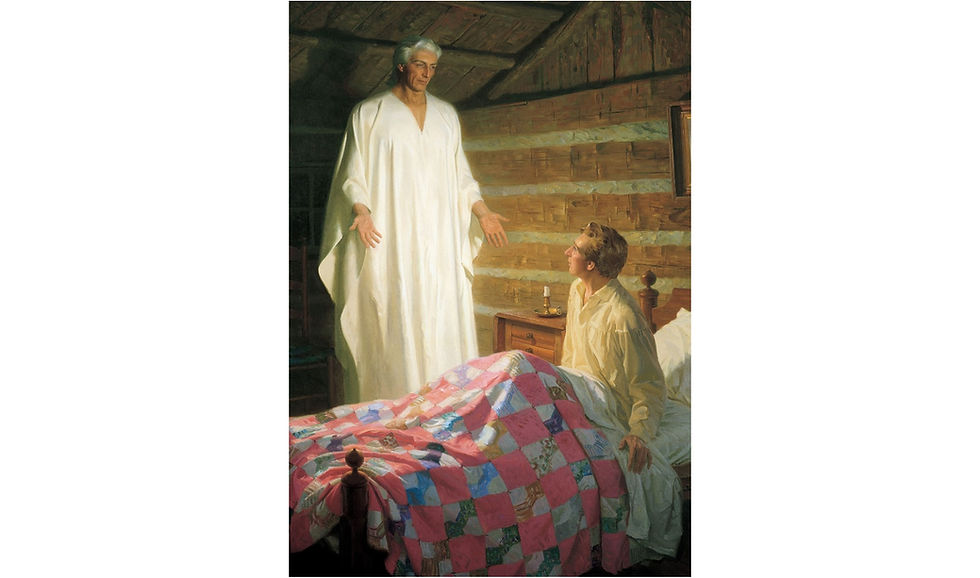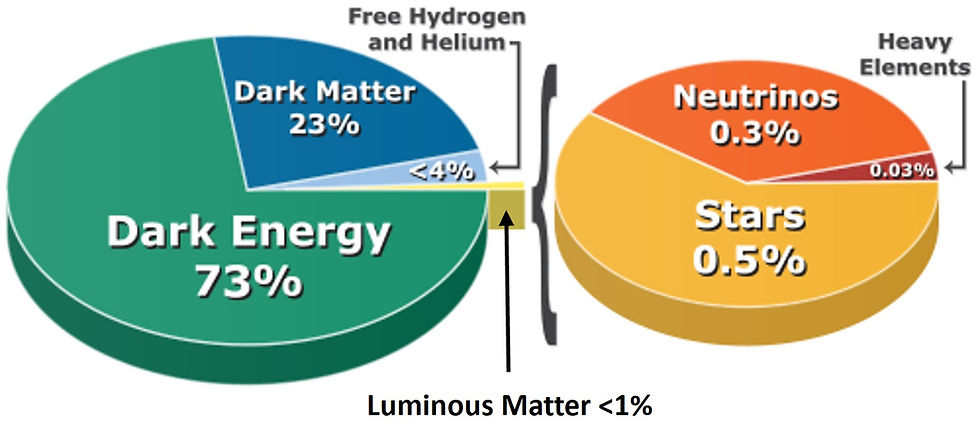I Saw Another Angel Fly in the Midst of Heaven
- stephenstrent7

- Dec 23, 2023
- 4 min read

The Angel Moroni Appears to Joseph Smith, by Tom Lovell (1909-1997); The Church of Jesus Christ of Latter-day Saints image (62492); GAK 404; GAB 91
Where Science Meets Religion by Trent Dee Stephens, PhD, for the Come Follow Me lesson December 25-31
I will not be discussing Revelation 15-22 in this post. Rather, in preparation for next year’s Book of Mormon discussions, I am going back to Revelation 14:6, “And I saw another angel fly in the midst of heaven, having the everlasting gospel to preach unto them that dwell on the earth, and to every nation, and kindred, and tongue, and people…”
In the first century AD, when this revelation was received and distributed to members of the Church, people had no idea how angels could fly unless they had wings — because the only things that they knew of “flying in the midst of heaven” had wings. Therefore, in almost all the art since that time, angels have been depicted with wings.

Winged angels, Basilica di Santa Maria Maggiore, Rome (432-440)

Song of the Angels by William-Adolphe Bouguereau (1881)
For example, both in the mosaic in the Basilica di Santa Maria Maggiore, Rome, created around 432-440 AD, and in the Song of the Angels painted by William-Adolphe Bouguereau in 1881, angels are shown with wings.
However, when the prophecy in Revelation 14:6 was literally fulfilled on 21 September 1823, the “…angel [that flew] in the midst of heaven, having the everlasting gospel to preach unto them that dwell on the earth, and to every nation, and kindred, and tongue, and people…” flew in a much different, and much more modern way.
Joseph Smith stated about the incident (Joseph Smith History):
Verse 30: “While I was thus in the act of calling upon God, I discovered a light appearing in my room, which continued to increase until the room was lighter than at noonday, when immediately a personage appeared at my bedside, standing in the air, for his feet did not touch the floor.”
Verse 43: “After this communication, I saw the light in the room begin to gather immediately around the person of him who had been speaking to me, and it continued to do so until the room was again left dark, except just around him; when, instantly I saw, as it were, a conduit open right up into heaven, and he ascended till he entirely disappeared, and the room was left as it had been before this heavenly light had made its appearance.”
A “conduit”…wow! I don’t know about you, but that word certainly stretches my imagination. In the 1820s, I don’t know of anyone talking about flying through heaven via conduits.
Joseph Smith also recounted in his History (vs. 16-17) what happened at the time we now call the First Vision: “… I saw a pillar of light exactly over my head, above the brightness of the sun, which descended gradually until it fell upon me…When the light rested upon me I saw two Personages, whose brightness and glory defy all description, standing above me in the air.”
Everyone else working on “manned flight” at the time, it appears, was working on winged aircraft. During the first half of the nineteenth century, the English engineer and inventor, George Cayley, designed a number of different gliders that were controlled by body movements. Cayley improved the wing structure over time, added a tail for stability, and recognized the need for powered flight.1
During the latter part of the century, the German engineer, Otto Lilienthal, designed the first glider that carried a person over a distance. His book on aerodynamics, published in 1889, was employed by the Wright Brothers for their airplane designs.2
Also in the late nineteenth century, the American astronomer and physicist, Samuel Langley, was the first to add an engine to an airplane. His steam-powered model aircraft flew successfully, but the full-sized version was too heavy for flight.3
In 1894, the French-American civil engineer, Octave Chanute, published his book, Progress in Flying Machines, which analyzed all the technological advances in aviation up to his time. The Wright Brothers employed much of the information in his book as the basis for many of their own experiments. They also contacted Chanute for advice on their technological advancements. Then, of course, Orville and Wilbur Wright were the first to accomplish sustained, heavier-than-air, powered, human flight at Kitty Hawk, North Carolina on 17 December 1903.4
An alternative way for someone to “fly through heaven” is teleportation, which is the hypothetical transportation of someone from one place to another without physically traversing the distance between them, and which is now a common theme in science fiction. The word teleport has been documented as early as 1878.5 The earliest known Sci Fi story describing a “matter transmitter” was Edward Mitchell’s “The Man Without a Body,” in 1877.6
Teleporters involving a “beam” first appeared when the Sci Fi TV series Star Trek aired 8 September 1966. The “transporter” aboard the Star Ship Enterprise converted a person or an object into energy and then beamed it to a target location or returned it back to the transporter aboard the ship, where it was reconverted into regular matter.
Two possibilities exist for Joseph Smith’s account of his encounter with Moroni “flying through the midst of heaven:” either he was trying to explain in words what he actually saw, or he was making the whole thing up. Some detractors of the Book of Mormon have tried to explain away Joseph Smith’s involvement in that book by, primarily, attempting to argue that someone else wrote the book. Those arguments are weak at best and preposterous at the usual. The Book of Mormon is a very real, tangible product of the nineteenth century.
The only question is whether it is a divine translation, as Joseph Smith purports it to be, or it is a work of fantasy. The same may be said of Joseph’s account of his experiences as recorded in his History — except that no one doubts that Joseph Smith wrote his History.
If the History and the Book of Mormon are fantasies, then they stand among the greatest works of fantasy and science fiction ever written. Joseph’s description of Moroni being teleported via a conduit of light predates any fictional teleportation account by over fifty years and the description of a transporter by over one hundred forty years. Why don’t Joseph Smith’s critics give him his rightful place — if his accounts are fictional — as the Sci Fi writer who first invented teleportation? Why are there no university classes teaching the History and the Book of Mormon as great works of fantasy and science fiction? Just ignoring them is not an option, they have to either be accepted as the products of supernatural events, as Joseph Smith posits, or they must be accepted as among the greatest works of science fiction and fantasy ever produced.
Trent Dee Stephens, PhD
References
1. www.grc.nasa.gov/www/k-12/UEET/StudentSite/historyofflight.html; retrieved 17 December 2023
2. Ibid
3. Ibid
4. Ibid
5. The Latest Wonder; nla.gov.au., 29 June 1878; retrieved 17 December 2023
6. Teleportation, In The Science Fiction Experience; www.daviddarling.info/encyclopedia/T/teleportation.html; retrieved 17 December 2023



But remember, in true Trent Stephens's fashion, sometimes the inexplicable isn't unexplainable by science....yet. Bernoulli was good, but he simply couldn't explain flight completely. Here's an excerpt from my upcoming textbook:
"Remember that buoyancy is the upward force exerted by a fluid that opposes the weight of a partially or fully immersed object. Simple Archimedes principles from “On Floating Bodies” (246 B.C.E). In order to rise, the weight of the body relative to the upward force must decrease, or the force pushing up must increase. A simple hovering helicopter must create the same force as it weighs not to move. In other words, a 1 Kg bird must generate, according to Newtonian physics, 9.8 m/s-2 or 1N. 1N is the…